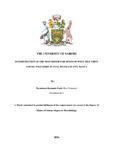| dc.description.abstract | Re-emerging infectious diseases can cause serious health and economic effects in a society.
West Nile virus fever is a zoonotic arboviral infection maintained in nature within a cycle
between mosquito vectors and birds. This virus was first isolated in Uganda with subsequent
reports of epidemics globally. In order to establish effective monitoring and surveillance
measures, knowledge on the ecological and transmission patterns is necessary. This study
aimed at determining the main reservoir hosts of West Nile virus. Blood samples were
obtained from 361 randomly sampled wild birds in Tana River County, Kenya, in the months
of October and December 2014. The samples were subjected to nucleic acid based screening
for West Nile virus using the virus specific primers in real time polymerase chain reaction
after total ribonucleic acid extraction. The amplification was carried out against a standard
curve generated using serial dilutions of a synthetic positive control. A total of 65 samples
exhibited positive amplification with a high cycle threshold value of 30. Visualization of the
amplified fragments on agarose gel revealed bands of targeted 445 base pair fragments.
Sanger sequences of 5 of the samples indicated genetic relationship to West Nile virus
XJ11141, XJ11129, XJ11148 and Ast-986 strains initially isolated from China and Russia.
Phylogenetic analysis clustered the isolates with described lineage 1 strains in Genebank. A
regression analysis indicated that the sampling location influenced the occurrence of West
Nile virus while species, age, weight and sex of the birds did not have any effect. This study
provides baseline information on the existing circulation of the virus in this region among
wild birds that could spill into the human population and points to the need for
implementation of surveillance programs. Therefore, there is need to enhance awareness in
the public health department of this region to contain its circulation.
Keywords: Arbovirus, Polymerase chain reaction, Reverse transcription, West Nile Virus,
Zoonosis. | en_US |



